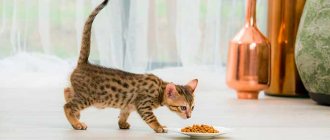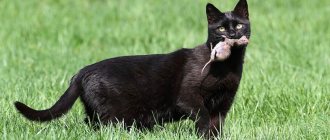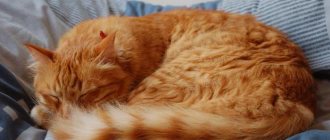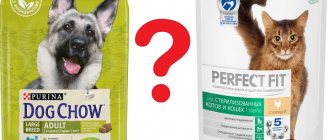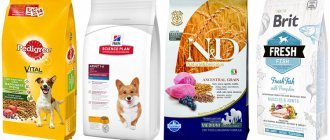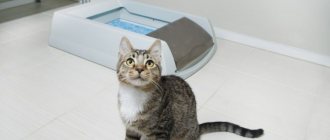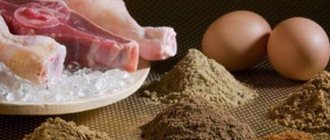10159Administration
With the advent of commercial pet food, many pet owners breathed a sigh of relief, believing that it was enough to choose the right brand once and the cat’s nutrition problem would be solved forever.
If a cat stops eating dry food, many people start to panic. What is the reason and what should the owner do?
The main probable reasons for refusing dry food:
- owners do not monitor the cleanliness of cat dishes and water,
- tired of food
- the pet's appetite has temporarily deteriorated,
- the quality of the feed has changed,
- the cat is seriously ill.
Lack of habit
Most often, a situation where a cat ignores dry food occurs if the animal was not accustomed to this product initially. At the same time, one should not conclude that the cat “considers” it to be unsuitable food; it’s just that, unlike wet foods, dry food smells different and has an unusual consistency.
All you need to do is get your pet used to a dry diet, starting with feeding food that the cat will eat with pleasure (this can be either canned pet food or a natural diet), and gradually adding dry food pellets to it.
At first, they should make up no more than 15-20% of the total serving volume, and then their number is gradually increased until complete replacement. On average, such a smooth transition takes one to two weeks.
If the cat is capricious and leaves dry food granules in the bowl, eating everything else, then you can act harshly by simply depriving the pet of any other food. A hungry animal will sooner or later start eating what is given.
The cat has problems
The cat refuses to eat dry food. What to do and where to go? The most effective option to accustom a kitten to dry food is to gradually add it to the regular food that the animal likes. The important thing is to do this partially and in small portions. This way your pet will begin to gradually get used to the new food.
Then you should slightly increase the amount of dry food. You need to continue until the cat's bowl is 100% filled with dry food. Under no circumstances should you switch directly from regular food to a finished product. Even if the cat likes the new treat. This can be stressful for his digestive system.
Eating disorder
The reason why a cat does not eat dry food may be constant feeding of other foods. Many owners like to treat their pets to wet diets, considering them just a treat or treat. At the same time, it is a food that contains enough calories to curb your appetite.
Usually, cats spoiled in this way begin to demand something tasty, ignoring the dry food in the bowl, and are so insistent that the owners give their pet a snack again and again, and then worry about giving up the dry food.
Another fairly common situation is non-compliance with feeding standards. Dry food pours out in a heap, and since cats tend to approach the bowl 10–15 times a day and eat a little, the owners, without noticing this and constantly contemplating a full bowl, conclude that their pet is not eating .
One has only to determine and weigh the daily requirement to the nearest gram, and it turns out that the cat copes with it perfectly. It is best to pour half a serving in the morning and half in the evening, then it will be even easier for you to determine how much your pet has eaten.
cat won't eat dry food
For kittens under one year old, an excess of protein is not dangerous, rather a deficiency is undesirable... Look at the condition... But if the kitten is active and wandering around - even if it weren’t freely available - then at least increase the dose p... PS: I have extremely active kittens, food is freely available (well, more precisely, I sprinkle it 2 times a day - and very much by eye because the cat is not alone, but I don’t dose it).. In principle, a very approximate norm is written on the pack - in reality, the cat may need both more than the norm and less (well, everything is like with people - some eat everything they can get their hands on - and are slim, some ate a little more - the result is on the face) Therefore, you should not blindly follow the norms - turn on your analytical skills, look at the cat - and then we will decide... PS: Mine, for example, are extremely active - and by eye they eat 35 percent more than normal - but still they are all slender.. You also need to take into account the activity/breed (a Scotsman can’t compare with an Orik in activity, yeah) PS: we’re happy to eat grain-free Arden Grange - they like it , I’m also quite happy with it) Post has been edited by Vitaliya - 11/17/2014, 9:54 pm
The cat is not eating enough dry food, what should I do?
Physiological reasons for refusing dry food
Older animals, and this sometimes happens to young ones, may refuse dry food due to problems in the oral cavity. They experience pain when chewing granules and, in order to avoid it, do not approach the bowl, but at the same time they feel hungry and ask to eat. You can examine your pet’s mouth and, if you notice reddening of the gums (normally they are pale pink), loose teeth with signs of rotting, consult a veterinarian.
Cats may not eat dry food if it has gone bad. A person is not able to smell rancid fat, but cats smell it perfectly, and instinct tells them to refuse food that can cause poisoning. Store dry food in a cool, dark place in an airtight container or tightly wrapped bag, and never use expired food.
A short-term refusal of dry food and, which is very important, from any food in general, can also happen for other reasons related to external factors. For example, in very hot weather, many animals lose their appetite, it can also decrease for several days during estrus, and during severe stress it almost always disappears. In the latter case, the period of refusal to eat can last several days. Stress in cats is caused by any changes in the environment - moving to another place, the arrival of a new family member or pet, renovations in the apartment, etc.
Although loss of appetite due to stress is a natural phenomenon, this does not mean that it should not be addressed, as long-term stress is detrimental to a cat’s health. Therefore, try to provide your pet with a sense of security; cats get used to changes more easily if you temporarily limit their living space to one room, where “strangers” will not have access and where the animal, in a calm environment, will gradually become convinced that there is no danger.
The cat's feeding area or bowl is dirty
Cats, like all animals, love cleanliness because they instinctively understand that this is, indeed, the key to health. Dry food doesn't stain the bowl as much as wet food, but it still leaves small crumbs and traces of fat that deteriorate over time. Therefore, it is a good habit to wash the dishes your cat eats from every day.
It is customary to wash dishes from which people eat after each use, but owners are sometimes reluctant to wash animal bowls. This happens especially often when feeding dry food, because the owners think that it “doesn’t get dirty.” In fact, this is not at all true: when you chew granules, crumbs are formed that settle at the bottom of the bowl, and the fat with which they are soaked remains on its walls.
READ Kvamatel for cats and dogs. Kvamatel for cats: description of the drug and indications for use For impaired renal function
Depending on the ambient temperature, it takes from several hours to several days for fats to completely deteriorate in light and air, so wash your cat’s bowl daily with warm water and detergent. In summer, it is advisable to perform this procedure even more often. Otherwise, your cat's keen sense of smell will signal to her that the food is spoiled, even if you just poured fresh granules.
Health problems
Complete refusal of any food, accompanied by lethargy, discharge from the eyes or nose, vomiting or diarrhea is a very alarming sign that may indicate a serious illness. Even loss of appetite in itself in a general depressed state without any other obvious symptoms is a reason to consult a veterinarian. This is exactly the case when it is better to play it safe than to waste time. True, we repeat, we are talking about a complete refusal of any food, and if the cat does not eat only dry food, but at the same time eats treats with pleasure, then everything is in order with its health, and you only need to establish a normal feeding regime.
The cat asks for another food
Animals, and especially obligate (eating only meat) predators, such as cats, do not eat everything. Their olfactory and taste receptors are “tuned” in such a way as to subtly capture in food exactly those substances that their body needs. Therefore, refusing a certain dry food may not be a pet’s whim at all, because he feels that this product lacks the most important thing - proteins and fats of animal origin.
Owners should take the time to understand the ingredients in dry food and choose a product that contains a lot of meat. Such diets exist, and Acana and Orijen foods, consisting of 75% and 85% meat ingredients, respectively, are a prime example of this. Try changing the diet to a more meat-based one, and your cat will immediately develop an appetite!
Backup options
It is important to open the briquette with food right in front of the cat. Most animals will be attracted to this and will gobble up the food with interest. There is another interesting method - feeding the cat from your finger. The fact is that many cats will never touch the food in the bowl. They will lick this same food off their finger with great pleasure.
Let’s assume that the animal simply didn’t taste the food. But finger feeding will help you quickly get used to the food in his bowl. It is even possible to slightly open his mouth so that he can quickly feel the taste of food. If the kitten does not eat dry food, you now know what to do.
Why does your pet refuse to eat?
If you are confident in the quality of the product you are using, do not rush to change it, even if your cat suddenly begins to eat poorly.
Many owners begin to panic: they try options from other manufacturers, then another type, for example, canned food or natural food. Such leapfrog can only do harm and further discourage the animal’s appetite. Perhaps the cat is simply capricious because you often pamper it with treats (cat treats, food from your table). The cunning animal immediately realizes that it is not necessary to eat boring granules: all you have to do is meow pitifully and the owner will give you a “yummy” treat.
If your cat is not a good eater of dry food, we recommend eliminating all snacks and treats, especially when you are just starting to introduce him to a new type of food. As a last resort, you can skip a couple of feedings: usually after this, even the most capricious ones begin to crunch pellets briskly.
Do you want to know why an animal might not want to eat it? This may happen for the following reasons:
- The cat doesn't eat dry food because she simply doesn't like it. Try changing its brand, not necessarily to a more expensive product. She might be happy to eat the budget option. It all depends on your pet's personal taste preferences. You should not buy large quantities at once. Take a little at a time until you find exactly the one your cat likes.
- The cat stopped eating dry food, although she used to eat it with appetite - maybe she was just tired of the monotonous food. Try giving her canned fish or any liquid food. Pamper your pet with pates and meat purees. The cat refuses to eat dry food, give it wet food. Change the foods on the menu as often as possible, and your pet will always eat with pleasure.
- The cat does not eat dry food well because he does not like the smell and taste. This often happens if pet owners like to pour more food into a bowl than the animal can eat in a day. Over time, the product becomes damp and loses its aroma.
- The cat ate it for a month, and now categorically refuses to do it. Pet owners who prefer to make bulk purchases may encounter a similar problem. By buying packages that are too large, you run the risk of eventually getting a product that is unusable. Due to long-term storage, it can absorb moisture and foreign odors, which will significantly deteriorate its taste.
- Very often, cats refuse to eat from dirty dishes. Wash bowls every day. They should always be dry and clean.
- The lack of clean drinking water nearby can prevent a cat from weaning itself from eating dry food. If food gets into it, the animal may refuse to drink. Lack of water in the body can lead to disruptions in the digestive system, which can cause loss of appetite.
- The cat may not eat because he is small and is simply not used to such food yet. It will take patience and time to teach him to do this.
- You fed the animal with food you prepared yourself, and now you have decided to switch it to another type of food. This may cause the pet to protest, manifested by refusing to eat.
- Refusal not only from dry food, but also from any other food can be a symptom of various diseases. Perhaps your pet is sick and needs veterinary care.
There are many reasons that can cause a cat to refuse pelleted food. Some of them are associated with natural physiological factors, others are not normal and can threaten the cat’s life.
Diseases
Many diseases can provoke a refusal of dry food. The owner needs to pay attention to the general condition and behavior of the animal. If the cat is interested in the food, sniffs it and tries to eat, but at the last moment turns away or spits out the pellets, this may indicate damage to the gastrointestinal tract or the presence of a foreign body or neoplasm in it.
With dermatological diseases affecting the area around the mouth, the cat retains its appetite, but cannot eat due to pain
Pathology can affect not only the intestines or mucous membranes of the esophagus and stomach, but also the oral cavity. Animals often refuse dry food due to toothache. At first it causes discomfort, but the cat continues to eat. Later, as the pain intensifies, a kind of reflex arises, and the pet turns away from food.
We suggest you read: Is it possible to teach a cat commands?
Interest in wet food and natural products can be maintained: softened food causes less discomfort. With dental diseases, a pet may chew on hard objects in order to independently get rid of the source of pain. Most often, an injury or signs of pathology can be detected by visual examination, but in some cases an x-ray is required.
Tartar can lead to the loss of fangs, so regular brushing with a special brush is recommended.
New growths in the oral cavity can cause no less discomfort. During eating, they can be injured by teeth or hard granules. In some cases, this can cause bleeding. Most often, tumors can be detected independently. They can be soft, hard, movable, fixed, white, black, etc.
Depending on the location of the tumor, the animal may experience increased salivation and difficulty swallowing
With diseases and damage to the musculoskeletal system, a cat may refuse dry food and other food while maintaining appetite due to limited mobility and pain. In such cases, the animal experiences severe discomfort, meows, limps, drags its paws or cannot rise at all, defecates under itself, etc. The condition is one of the most dangerous, so it is important to carefully deliver the cat to the veterinarian without causing it additional pain.
In some cases, the animal completely refuses dry food. It has no interest in it or other food. The pet is hungry, but at the sight of food it immediately turns away or leaves. This symptom may accompany the following diseases and conditions:
- Intoxication. Poisoning is accompanied by rapid heartbeat, nausea, vomiting, digestive disorders, fever, etc. In severe cases, loss of orientation in space occurs. In a critical condition, the cat stops reacting to what is happening, and the body temperature drops. Possible failure of internal organs. In case of mild intoxication, after the poisoning is removed, the condition returns to normal without additional intervention. If the cat’s health deteriorates significantly, the cat is fed through a tube and given intravenous infusions to prevent dehydration.
- Lipidosis. The disease is characterized by excessive accumulation of fat in the liver. The animal may eat poorly or completely refuse food for a long period of time (2-4 weeks or more). The cat quickly loses weight, and the ribs, breastbone and hips become visible. The animal is worried about digestive disorders and jaundice. In case of lipidosis, appetite must be corrected as part of general therapy, since irreversible processes often begin to occur in the body.
- Internal injuries. The main signs of illness are hidden bleeding, swelling and severe pain. If the cat's gastrointestinal tract is damaged, blood may be detected in the stool. In the absence of severe exhaustion, the animal’s condition returns to normal on its own after treatment.
If the tissues of the urinary system have been injured, blood impurities or solid clots will be present in the urine; indirectly, color allows you to determine the location of damage - Infections. The reason for refusing dry food can be both gastrointestinal lesions and, for example, cystitis. In this case, poor appetite is associated with intoxication of the body by bacteria and their decay products. The animal definitely needs treatment, even if the symptoms have weakened or disappeared without treatment. Improvement in condition may indicate that the disease has become chronic.
- Gastrointestinal pathologies. The pet does not eat well or refuses dry food due to inflammation and pain in the abdomen, as well as nausea. If an animal eats both pellets and natural products, it may choose the latter. Foods that are high in liquid cause less pain due to their softer texture.
When feeling nauseous, your cat will often lick its nose. - Disorders of the central nervous system and brain. Most often this is observed with injuries. Appetite problems are associated with impaired transmission and recognition of nerve signals. As a result, the cat does not feel hungry while the body needs energy and nutrients. Treatment is mandatory; if necessary, the pet is fed through a tube.
- Helminthiasis. Infection with worms can occur through eating raw meat, contact with other animals, or accidentally ingesting parasite larvae along with insects, soil or water. With mild helminthiasis, weight loss, deterioration in general health, and mucus and blood in the stool are observed. Larvae or whole worms may be found in natural secretions and vomit. In severe cases, worms cause intestinal obstruction. After taking anthelmintics twice, the symptoms disappear; only animals in critical condition need additional correction.
- Inflammatory processes that accompany acute and chronic diseases. Deterioration of appetite can occur with any pathology due to the active functioning of the immune system. Most of the energy is spent by the body on eliminating inflammation, so the pet feels weak and loses its appetite.
- Intestinal obstruction. Refusal of dry food is associated with blockage of the gastrointestinal tract and the impossibility of normal movement of food and feces. In such cases, the cat experiences pain. With partial obstruction, the animal is bothered by bloating and diarrhea, with complete obstruction - constipation. Nausea appears. Without help, the pet may die. After normalization of the condition, the cat gradually returns to a normal diet.
We suggest you read: The cat shakes its ears a lot, reasons and what to do
Partial refusal of dry food and selectivity may be caused by visual or olfactory impairments. In this case, this is due to the unattractiveness of the food. Cats navigate by sight and smell, so if they lose their senses, they may suffer from poor appetite. If the situation does not improve after normalization of the pet’s condition and a course of therapy, owners are advised to use additional tricks to increase the attractiveness of the food.
How to gradually accustom a cat to dry food?
The entire training process will consist of several stages. First, you should soak the dry food in milk or broth. Of course, clean water will do. But in the first case, the food will be saturated and taste even better.
Secondly, constantly mixing such food with ordinary and familiar ones. And, as mentioned above, its gradual increase. Over time, you can conduct the following experiment. Place dry food next to regular food, without mixing, and watch the cat’s reaction. If your beloved pet eats both, then the job is done, if not, you should continue in the same way. If, despite all attempts on your part, the kitten does not want to eat dry food, you should use other methods.
The cat doesn't like the food
Sometimes the problem is not the pet, but the dry food itself. A cat doesn't eat well when he doesn't like it. Do not forget that she is a predator, which means that the most desired food for her is meat. It is best to buy dry food, in which meat components occupy the main part of the composition. Acana and Orijen diets contain between 75% and 85% meat, so animals tend to eat them happily.
Please note that cats, unlike dogs, are extremely picky and cautious eaters. Any change in the usual smell of food can cause a decrease in appetite. Remember when you opened the package and how it was stored: perhaps the dry granules have become airy or rancid. In this case, you will have to buy fresh packaging and in the future pay more attention to the proper storage of dry food.
In short, to keep granules fresh you need:
- a dark, cool place, but not too humid;
- an airtight container with a lid made of a chemically inert material (food grade plastic, metal);
- purchase packages that the animal will master in 4–6 weeks.
This also happens, and the “fault” is again the animal’s sense of smell - it is this that cats rely on when determining the composition of food. Naturally, WHO recommendations on proper nutrition do not come to mind in their memory, but instincts formed over millions of years of evolution are triggered. They tell the carnivore that food that does not contain enough meat is not suitable for them, that is, in fact, inedible.
In addition to meat, cats also react to the smell of animal fat, because it is much more valuable to them than vegetable fat, which can often be found in the composition of some foods. Try to find a diet in which meat ranks first in the list of ingredients, and animal or fish fat is used - and it is quite possible that your pet will forget about the whims. Read more about how to choose cat food here.
It is also worth mentioning that a cat may refuse food that has spoiled for some reason, so always check the expiration date on the packaging and store the product in a cool, dry place.
This can happen if the dry food that your pet previously liked has expired or storage conditions have not been met. Exposure to direct sunlight, excessive heat or humidity in dry food causes oxidation or, more simply, rancidity of fats, after which the product acquires an unpleasant odor.
Some cats are picky and enviably stubborn: if they don’t like some food, they will categorically refuse it. Of course, long-term fasting can force anyone to eat, but it is better not to conduct such cruel experiments, but to choose food for the cat that will suit its taste.
Loss of quality
We are not always with our pet. Everyday life requires us to constantly leave and leave. Then you have to give the cat food in reserve. But, as you know, after lying for some time, food loses its original smell and taste. Your pet may not like it. A similar situation arises when owners buy packages of food that are too large and the cat does not have time to eat everything. As a result, the product deteriorates and no longer meets its taste. Over a long period of time, it can change its smell or attract moisture.
We suggest you read: What is the difference between a British cat and a Scottish Fold?
In order for your cat to always eat with pleasure, his food should be in a clean and dry bowl. A cat is a fairly clean animal. The conclusion is that it is necessary to wash the bowl daily or at least every other day.
The choice of dishes also affects the cat's appetite. You should choose a container that is not deep, but spacious. It is desirable that it be heavy so that the pet cannot knock it over with its paw. Lack of clean water near the food can also cause him to refuse to eat. The thing is that cats simply need clean water.
An animal may not eat food when it is a kitten. His little body is not yet accustomed to such food, especially after his mother’s milk. It’s worth waiting until he grows up and starts eating it himself.
The next reason for an animal to refuse food is a sudden change in food. Let’s say a cat is fed food he has prepared himself, and then they want to switch him to food. Such a solution will most likely not yield results, since the animal is not accustomed to dry food.
There are also more serious reasons when a pet refuses not only dry food, but all food at once. In this case, the development of some disease is possible. A cat cannot tell us what hurts. If you have any suspicions, it is better to immediately take your pet to the veterinarian. Your beloved furry will certainly be helped there.
If your pet has no health problems, then teaching him to eat food is quite possible. All it takes is patience and time. In order to do this as quickly as possible and without unnecessary nerves, it is worth attracting the animal to a new food.
The addition of new family members or pets to the home, visits to the veterinary clinic, moving, and even rearranging furniture can cause stress in cats and, as a result, loss of appetite. In some animals, this condition can last for several days or even weeks, but as soon as the cat is finally convinced that the changes do not pose any threat to it, it will calm down and everything will return to normal.
A decrease in appetite can also occur in extreme heat, and this is also a temporary phenomenon, but in this case it is imperative to ensure that the cat has access to clean, fresh water.
